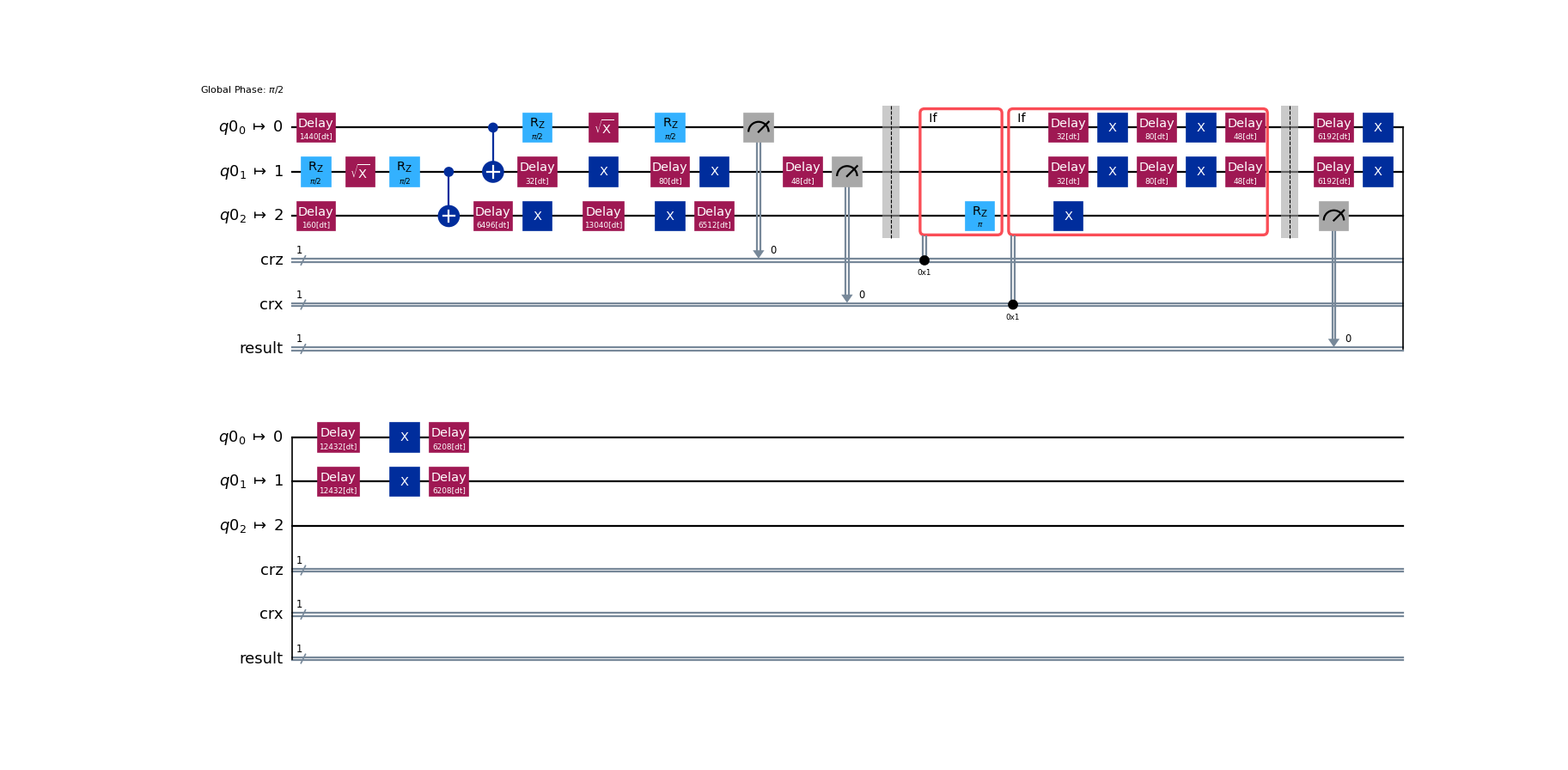Transpiler scheduling passes (qiskit_ibm_runtime.transpiler.passes.scheduling)¶
A collection of scheduling passes for working with IBM Quantum’s next-generation backends that support advanced “dynamic circuit” capabilities. Ie., circuits with support for classical control-flow/feedback based off of measurement results. For more information on dynamic circuits, see our Classical feedforward and control flow guide.
Warning
You should not mix these scheduling passes with Qiskit’s built in scheduling
passes as they will negatively interact with the scheduling routines for
dynamic circuits. This includes setting scheduling_method in
transpile() or
generate_preset_pass_manager().
Classes¶
The base class of padding pass. |
|
Dynamic circuits as-late-as-possible (ALAP) scheduling analysis pass. |
|
Dynamic circuits as-soon-as-possible (ASAP) scheduling analysis pass. |
|
For dynamic circuits the IBM Qiskit backend currently reports instruction durations that differ compared with those required for the legacy Qobj-based path. |
|
Padding idle time with Delay instructions. |
|
Dynamical decoupling insertion pass for IBM dynamic circuit backends. |
Example usage¶
Below we demonstrate how to schedule and pad a teleportation circuit with delays for a dynamic circuit backend’s execution model:
from qiskit.circuit import ClassicalRegister, QuantumCircuit, QuantumRegister
from qiskit.transpiler.preset_passmanagers import generate_preset_pass_manager
from qiskit.transpiler.passmanager import PassManager
from qiskit_ibm_runtime.transpiler.passes.scheduling import ALAPScheduleAnalysis
from qiskit_ibm_runtime.transpiler.passes.scheduling import PadDelay
from qiskit_ibm_runtime.fake_provider import FakeJakartaV2
backend = FakeJakartaV2()
# Use this duration class to get appropriate durations for dynamic
# circuit backend scheduling
# Generate the main Qiskit transpile passes.
pm = generate_preset_pass_manager(optimization_level=1, backend=backend)
# Configure the as-late-as-possible scheduling pass
pm.scheduling = PassManager([
ALAPScheduleAnalysis(target=backend.target),
PadDelay(target=backend.target)]
)
qr = QuantumRegister(3)
crz = ClassicalRegister(1, name="crz")
crx = ClassicalRegister(1, name="crx")
result = ClassicalRegister(1, name="result")
teleport = QuantumCircuit(qr, crz, crx, result, name="Teleport")
teleport.h(qr[1])
teleport.cx(qr[1], qr[2])
teleport.cx(qr[0], qr[1])
teleport.h(qr[0])
teleport.measure(qr[0], crz)
teleport.measure(qr[1], crx)
with teleport.if_test((crz, 1)):
teleport.z(qr[2])
with teleport.if_test((crx, 1)):
teleport.x(qr[2])
teleport.measure(qr[2], result)
# Transpile.
scheduled_teleport = pm.run(teleport)
scheduled_teleport.draw(output="mpl", style="iqp")
(Source code, png, hires.png, pdf)

Instead of padding with delays we may also insert a dynamical decoupling sequence
using the PadDynamicalDecoupling pass as shown below:
from qiskit.circuit.library import XGate
from qiskit_ibm_runtime.transpiler.passes.scheduling import PadDynamicalDecoupling
dd_sequence = [XGate(), XGate()]
pm = generate_preset_pass_manager(optimization_level=1, backend=backend)
pm.scheduling = PassManager(
[
ALAPScheduleAnalysis(target=backend.target),
PadDynamicalDecoupling(target=backend.target, dd_sequences=dd_sequence),
]
)
dd_teleport = pm.run(teleport)
dd_teleport.draw(output="mpl", style="iqp")
(Source code, png, hires.png, pdf)

When compiling a circuit with Qiskit, it is more efficient and more robust to perform all the
transformations in a single transpilation. This has been done above by extending Qiskit’s preset
pass managers. For example, Qiskit’s transpile() function internally builds
its pass set by using generate_preset_pass_manager().
This returns instances of StagedPassManager, which can be extended.